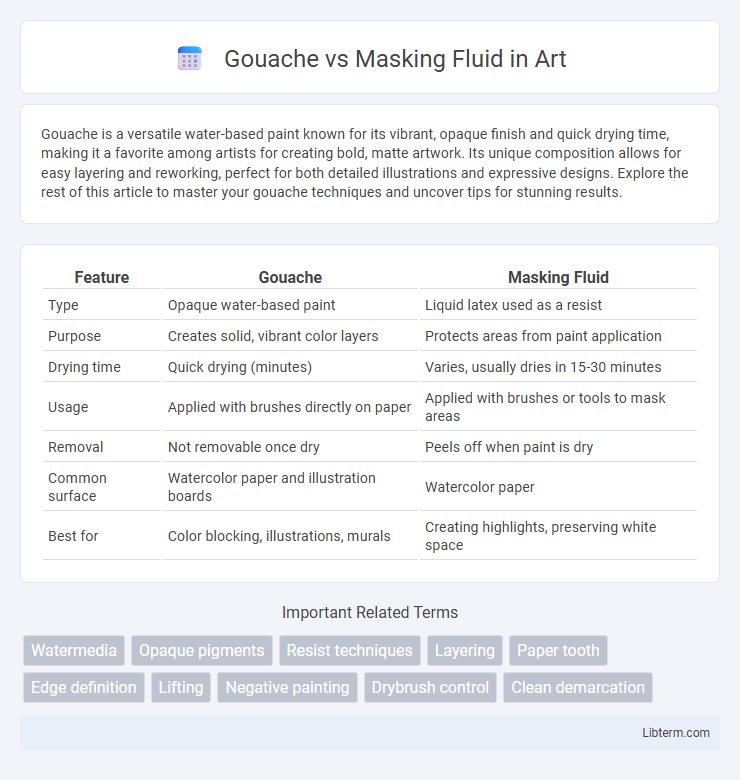Gouache is a versatile water-based paint known for its vibrant, opaque finish and quick drying time, making it a favorite among artists for creating bold, matte artwork. Its unique composition allows for easy layering and reworking, perfect for both detailed illustrations and expressive designs. Explore the rest of this article to master your gouache techniques and uncover tips for stunning results.
Table of Comparison
| Feature | Gouache | Masking Fluid |
|---|---|---|
| Type | Opaque water-based paint | Liquid latex used as a resist |
| Purpose | Creates solid, vibrant color layers | Protects areas from paint application |
| Drying time | Quick drying (minutes) | Varies, usually dries in 15-30 minutes |
| Usage | Applied with brushes directly on paper | Applied with brushes or tools to mask areas |
| Removal | Not removable once dry | Peels off when paint is dry |
| Common surface | Watercolor paper and illustration boards | Watercolor paper |
| Best for | Color blocking, illustrations, murals | Creating highlights, preserving white space |
Introduction to Gouache and Masking Fluid
Gouache is an opaque watercolor paint known for its vibrant colors and smooth, matte finish, favored by artists for its versatility in layering and reworking. Masking fluid is a liquid latex used to preserve white areas or protect parts of a painting from gouache or watercolor application, enabling sharp edges and intricate details. Both materials are essential in watercolor painting for achieving clean, controlled designs and dynamic contrasts.
What is Gouache?
Gouache is a type of opaque watercolor paint known for its vibrant color and matte finish, widely used in illustration, design, and fine art for its ability to create solid, even layers. This paint consists of pigment, water, a binding agent like gum arabic, and an inert white pigment such as chalk, which enhances opacity and coverage. Artists favor gouache for its quick-drying properties and versatility in producing detailed work or broad, flat color areas.
What is Masking Fluid?
Masking fluid is a liquid latex product used in watercolor and gouache painting to preserve areas of the paper by creating a protective barrier against paint. It dries to a rubbery film that can be peeled off once the surrounding paint is dry, revealing untouched white or unpainted sections underneath. Artists rely on masking fluid to maintain sharp edges, intricate details, and highlights without disturbing the base layer of gouache or watercolor.
Key Differences Between Gouache and Masking Fluid
Gouache is an opaque water-based paint known for its vibrant color and smooth, matte finish, while masking fluid is a liquid latex used to preserve white areas on paper by acting as a resistant barrier during painting. Gouache allows for layering and blending colors directly on the surface, whereas masking fluid provides control over negative space by protecting parts of the paper from paint application. Masking fluid must be removed carefully once the paint dries, whereas gouache becomes part of the artwork's final texture and color saturation.
Popular Uses for Gouache in Art
Gouache is widely used in illustration, graphic design, and fine art for its vibrant, opaque colors and smooth matte finish. Artists favor gouache for detailed work, layering techniques, and creating bold, flat areas of color in posters and animation backgrounds. Unlike masking fluid, which protects areas from paint, gouache itself serves as a versatile medium for expressive brushwork and quick corrections.
Creative Techniques with Masking Fluid
Masking fluid enhances gouache painting by preserving pristine white areas and intricate details during multiple layering stages. This technique allows artists to apply vibrant gouache washes without blending unwanted colors, creating sharp contrasts and texture variations. Experimenting with masking fluid enables dynamic effects like controlled patterning and resist textures, expanding creative possibilities in gouache artwork.
Combining Gouache and Masking Fluid
Combining gouache and masking fluid allows artists to preserve highlights and intricate details while painting opaque, matte layers with gouache. Masking fluid acts as a protective barrier, preventing gouache paint from adhering to selected paper sections, enabling clean and sharp contrasts once removed. This technique enhances control over the composition, making it ideal for detailed illustrations and mixed media artwork where layering precision is essential.
Pros and Cons: Gouache vs Masking Fluid
Gouache offers vibrant, opaque color with easy reactivation using water, making it ideal for layering and corrections but can be prone to cracking when applied thickly or over dried layers. Masking fluid preserves white spaces and fine details by creating a removable barrier, enhancing precision but may damage delicate paper surfaces or lift underlying paint if removed aggressively. Choosing between gouache and masking fluid depends on the desired control over paint application, texture sensitivity, and workflow preferences in watercolor or mixed media projects.
Tips for Beginners Using Gouache and Masking Fluid
When using gouache and masking fluid, beginners should apply masking fluid on dry paper before painting to preserve white areas and intricate details. Wait until the gouache layer is fully dry before carefully removing the masking fluid to avoid tearing the paper or smudging colors. Experimenting with different brush sizes for precise application and practicing on scrap paper helps achieve smoother results and better control over color layering.
Conclusion: Choosing the Right Medium for Your Artwork
Choosing between gouache and masking fluid depends on the artist's desired effect and technique. Gouache provides vibrant, opaque color ideal for detailed layering, while masking fluid offers precise protection of paper areas for sharp highlights and clean edges. Combining both can enhance complexity and control in mixed media artworks, making them complementary rather than mutually exclusive.
Gouache Infographic

 libterm.com
libterm.com